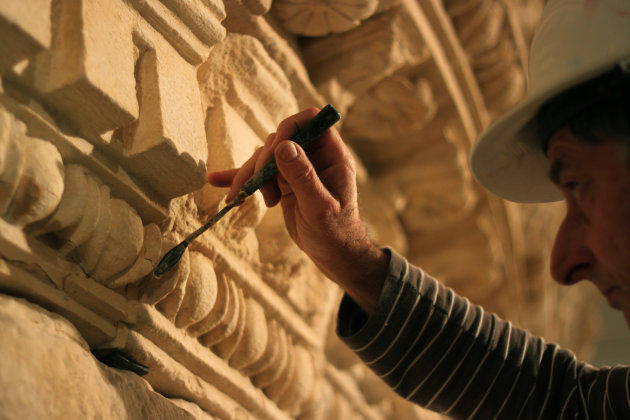Israel to open exhibit on biblical King Herod
JERUSALEM (AP) — Israel's
national museum said Tuesday it will open what it calls the world's
first exhibition devoted to the architectural legacy of biblical King Herod, the Jewish proxy monarch who ruled Jerusalem and the Holy Land under Roman occupation two millennia ago.
The display includes the reconstructed tomb and sarcophagus of one of
antiquity's most notable and despised figures, curators say.
Modern day politics are intruding into this ancient find. Palestinians object to the showing of artifacts found in the West Bank. The Israeli museum insists it will return the finds once the exhibit closes.
About 30 tons of artifacts — including hundreds of tiny shattered
shards pieced back together — are going on display at the Israel Museum
in Jerusalem in a nine-month exhibition opening Feb. 12.
Museum director James Snyder said the exhibit, "Herod the Great," is the museum's largest and most expensive archaeological project to date.
"It's a name that's always on everyone's lips," Snyder said, "And yet there has never been an exhibit devoted to his material."Herod was vilified in the New Testament as a bloodthirsty tyrant who massacred Bethlehem's male children to try to prevent the prophesied birth of Jesus. He is also said to have murdered his wife and sons.
Herod was also revered for his ambitious building projects, including his lavish desert palaces and an expansion of the Second Jewish Temple complex in Jerusalem. The Western Wall, today the holiest site where Jews are permitted to pray, was a retaining wall for the compound.
Herod's final grandiose project was to prepare for death. Curators believe Herod constructed an extravagant, 25-meter-high (80-foot-high) tomb. Israeli archaeologist Ehud Netzer spent 35 years of his career searching for it.
In 2007, Netzer drew international attention when he announced he had found what he believed was the tomb at the Herodion,
the ruler's winter palace, located on a cone-like hill that still today
juts out prominently in the barren landscape of the Judean Desert, near
the West Bank city of Bethlehem.
In 2008, the archaeologist approached the Israel Museum
about creating an exhibit that would display artifacts from one of the
greatest finds of his career. While surveying the Herodion site with museum staff, Netzer fell to his death. Museum staff pushed forward with planning the exhibit.
In 2011, the museum used a crane to remove dozens of half-ton columns
and the roof of what Netzer identified as the top floor of Herod's
tomb, which he thought held his sarcophagus. Each stone was affixed with
an electronic chip so it could be more easily be put back together at
the Israel Museum.Three sarcophagi were found at the site, and curators believe one was Herod's. Though it bears no inscription, it is made of a special reddish stone, found smashed into hundreds of pieces. The Jewish zealots who took over the Herodion after Herod's death likely smashed the sarcophagus to pieces, destroying the symbol of a man who worked with the empire they were rebelling against, curators said.
"It's not 100 percent. But archaeology is never about 100 percent," said co-curator Dudi Mevorah. "The circumstantial evidence points to one man." The sarcophagus will also be on display.
Archaeologist Joe Zias, who did not participate in the excavation or the exhibition, said he believes the tomb was likely that of Herod.
"It's a monumental tomb out in the middle of nowhere in a place he built for himself," Zias said. "It's as authentic as one could ask for."
The museum exhibit also features a reconstructed throne room from one of Herod's palaces in Jericho, and a full-sized replica of Herod's theater viewing room at the Herodion, incorporating detailed fresco wall paintings and other decorative elements that museum staff collected on site.
There are still pieces of the puzzle left to assemble. At the museum's lab Tuesday, workers were still rushing to fit together all the small stucco wall lining pieces found to display in the exhibit. One fresco wall painting, found in tiny fragments, has taken 2 1/2 years to reassemble.
Other items include the paint
jars used for Herod's frescos and plump jugs of wine imported from south
Italy labeled in Latin characters, "Herod King of Judea."
The museum's exhibit is almost entirely made up of finds from the West Bank — a point of contention with the Palestinians.Hamdan Taha, the assistant deputy minister in charge of antiquities in the Palestinian Authority, said the excavation and exhibit were not coordinated with Palestinian officials.
"The excavation is another example of utilization of archaeology and history for ideological purposes ... which will not serve to establish comprehensive peace between the two peoples, the Palestinian and Israeli peoples," Taha said.
Taha said excavating
archaeological objects from the West Bank without Palestinian permission
is in violation of an international convention which governs
antiquities in occupied territories.
Museum director James Snyder said
he had not received complaints from the Palestinian Authority. He said
Israel is responsible for custodianship of archaeology in the West Bank,
and that the museum would, in compliance with international law, return
the Herodion artifacts to their original site when the exhibit closes.
"It's important we take that responsibility seriously," Snyder said.
___
Follow Daniel Estrin: www.twitter.com/danielestrin

No comments:
Post a Comment